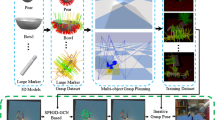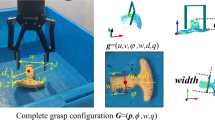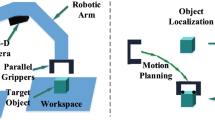Abstract
Recent advances in deep learning have enabled robots to grasp objects even in complex environments. However, a large amount of data is required to train the deep-learning network, which leads to a high cost in acquiring the learning data owing to the use of an actual robot or simulator. This paper presents a new form of grasp data that can be generated automatically to minimize the data-collection cost. The depth image is converted into simplified grasp data called an irregular depth tile that can be used to estimate the optimal grasp pose. Additionally, we propose a new grasping algorithm that employs different methods according to the amount of free space in the bounding box of the target object. This algorithm exhibited a significantly higher success rate than the existing grasping methods in grasping experiments in complex environments.
Similar content being viewed by others
References
H. Kim, J. Jo, Z. Teng and D. Kang, “Text detection with deep neural network system based on overlapped labels and a hierarchical segmentation of feature maps,” International Journal of Control, Automation and Systems, vol. 17, no. 6, pp. 1599–1610, 2019.
J. Redmon and A. Angelova, “Real-time grasp detection using convolutional neural networks,” Proc. of IEEE International Conference on Robotics and Automation (ICRA), IEEE, pp. 1316–1322, 2015.
M. Li, K. Hang, D. Kragic, and A. Billard, “Dexterous grasping under shape uncertainty,” Robotics and Autonomous Systems, vol. 75, pp. 352–364, 2016.
M. Gualtieri, A. Ten Pas, K. Saenko, and R. Platt, “High precision grasp pose detection in dense clutter,” Proc. of IEEE/RSJ International Conference on Intelligent Robots and Systems (IROS), IEEE, pp. 598–605, 2016.
A. Zeng, S. Song, K. Yu, E. Donlon, F. R. Hogan, M. Bauza, D. Ma, O. Taylor, M. Liu, E. Romo, N. Fazali, F. Alet, N. C. Dafle, R. Holladay, I. Morona, P. Q. Nair, D. Greem, I. Taylor, W. Liu, T. Funkhouser, and A. Rodriguez, “Robotic pick-and-place of novel objects in clutter with multi-affordance grasping and cross-domain image matching,” Proc. of IEEE International Conference on Robotics and Automation (ICRA), IEEE, pp. 1–8, 2018.
L. Pinto and A. Gupta, “Supersizing self-supervision: Learning to grasp from 50k tries and 700 robot hours,” Proc. of IEEE International Conference on Robotics and Automation (ICRA), pp. 3406–3413, 2016.
J. Mahler, J. Liang, S. Niyaz, M. Laskey, R. Doan, X. Liu, J. A. Ojea, and K. Goldberg, “Dex-net 2.0: Deep learning to plan robust grasps with synthetic point clouds and analytic grasp metrics,” Robotics: Science and Systems (RSS), 2017.
D. Quillen, E. Jang, O. Nachum, C. Finn, J. Ibarz, and S. Levine, “Deep reinforcement learning for vision-based robotic grasping: A simulated comparative evaluation of off-policy methods,” Proc. of IEEE International Conference on Robotics and Automation (ICRA), IEEE, 2018.
K. He, G. Gkioxari, P. Dollar, and R. Girshick, “Mask R-CNN,” Proceedings of the IEEE International Conference on Computer Vision, pp. 2961–2969, 2017.
D. Kim, H. Jo, and J. Song, “Grasping method in a complex environment using convolutional neural network based on modified average filter,” Proc. of IEEE International Conference on Ubiquitous Robots (UR), IEEE, 2019.
A. Graves, “Generating sequences with recurrent neural networks,” arXiv preprint arXiv:1308.0850, 2013.
S. Wold, K. Esbensen, and P. Geladi, “Principal component analysis,” Chemometrics and Intelligent Laboratory Systems, vol. 2, pp. 37–52, 1987.
Author information
Authors and Affiliations
Corresponding author
Additional information
Publisher’s Note Springer Nature remains neutral with regard to jurisdictional claims in published maps and institutional affiliations.
This research was supported by the MOTIE under the Industrial Foundation Technology Development Program supervised by the KEIT (No. 20008613).
Da-Wit Kim received his B.S. degree in aerospace & mechanical engineering from Korea Aerospace University in 2018 and his M.S. degree in mechatronics from Korea University in 2020.
HyunJun Jo received his B.S. degree from the School of Mechanical Engineering of Korea University in 2016. He is currently pursuing a Ph.D. degree at the School of Mechanical Engineering of Korea University. His research interests include deep learning, robot manipulation, and computer vision.
Jae-Bok Song received his B.S. and M.S. degrees in mechanical engineering from Seoul National University in Seoul, Korea, in 1983 and 1985, respectively. He received a Ph.D. in mechanical engineering from M.I.T. in 1992. He has been a professor in the Department of Mechanical Engineering at Korea University since 1993. His research interests include robot safety, manipulator design and control, and AI-based robot applications. He is a senior member of IEEE.
Rights and permissions
About this article
Cite this article
Kim, DW., Jo, H. & Song, JB. Irregular Depth Tiles: Automatically Generated Data Used for Network-based Robotic Grasping in 2D Dense Clutter. Int. J. Control Autom. Syst. 19, 3428–3434 (2021). https://doi.org/10.1007/s12555-019-0758-1
Received:
Revised:
Accepted:
Published:
Issue Date:
DOI: https://doi.org/10.1007/s12555-019-0758-1




